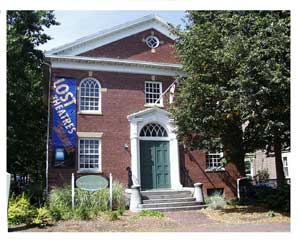
Hands-on workshop on How to Repair Windows Yourself takes place Saturday, June 29, 10 a.m.-3 p.m. at the Somerville Museum, One Westwood Road.
Need to improve your old windows? Thinking about replacing them? Think again! Come to a hands-on workshop sponsored by the City of Somerville Historic Preservation Commission and Historic Somerville on How to Repair Windows Yourself on Saturday, June 29, 10 a.m.-3 p.m. at the Somerville Museum, One Westwood Road. With proper tools, knowledge, and care, your windows can last for many years. This workshop will be a hands-on demonstration with an actual window from the Somerville Museum.
Why Restore Instead of Replace? It’s environmentally friendly, energy efficient, and cost effective, and old windows are higher quality and they preserve the character of your house as well. The class is $50 per person, with a maximum of 15, to allow for individual attention. All proceeds will go to the Somerville Museum Building Fund to help support their Access For All ADA Project. Instructor David Liberty has been restoring people’s windows since 1985, and he has been featured on PBS’s This Old House and is well-known in the Greater Boston Preservation community. To register, contact SHPC Executive Director Brandon Wilson at bwilson@somervillema.gov or 617-625-6600 x2532.
Windows: Reasons to Repair Instead of Replace
Replacement Windows do not live up to their “lifetime guarantee”
- Approximately 30% of windows being replaced each year are less than 10 years old[1]
- Window manufacturers falsely advocate their “lifetime guarantee.” These guarantees are usually non-transferable and cannot pass from owner to owner.
- Replacement windows pale in comparison to the performance life exhibited by historic windows, which can last up to 100 years or more with little maintenance.[2]
- According to the fine print of these guarantees, the maximum refund you will receive (if you don’t save 40% in energy costs) is $500, a meager return on an expensive investment.[3]
Windows are responsible for very little lost heat and energy
- “Adding just 3 ½ inches of fiberglass insulation in the attic has three times the R factor impact as replacing a single pane window with no storm window with the most energy efficient window.[4]”
- Most buildings lose more heat through the roof and un-insulated walls than through windows.[5]
- Infiltration of outside air (rather than heat lost through the glass) can account for as much as 50 percent of the total heat loss of a building.[6]
Wood windows constructed before 1940 contain high quality wood unmatched by newer windows
- Old windows are created of high quality old, dense wood. Disposing of them destroys this rare natural resource.[7]
- Old wood windows are made of denser and higher quality wood that is generally more rot- and warp-resistant than modern wood.[8]
- The performance of traditional joinery is unmatched.[9]
With proper care and maintenance, historic wood windows can be just as energy efficient as a new window
- The energy efficiency of retrofitted historic windows can meet and even exceed the efficiency of replacement units.[10]
- An old wood window combined with a storm window is about 15% more energy efficient than a new replacement window.[11]
Unneeded window replacements contribute to the United States’ landfill problems
- Reusing historic windows reduces environmental costs by eliminating the need for removal and disposal of existing units[12]
- It is far greener to retain and repair an existing window than to replace it.[13]
- A poorly performing window that requires quick replacement means additional debris in landfills, resources extracted for production, and energy for manufacturing and transport, neither of which are sustainable.[14]
Replacement Windows are not nearly as cost effective or energy efficient as marketed
- It is far less expensive to restore rather than replace
- According to studies, it can take 240 years to recoup enough money in energy savings to pay back the cost of installing replacement windows.[15]
- Replacing original windows wastes their embodied energy (the total expenditure of energy involved in the creation of a building and its constituent materials)[16]
- Preserving historic windows conserves their embodied energy and also eliminates the need to spend energy on replacement windows[17]
- Aluminum, vinyl, and wood composite replacement windows will not last as long as the original.[18]
- Parts of modern windows cannot be individually replaced.
- Replacement windows incorporate insulated glass (IG) units, which are unreliable. When IG units fail they are difficult and time consuming to replace.[19]
- New replacement windows rarely fit historic openings, resulting in a poor fit that does little to mitigate the drafts and heat loss that prompted the replacement in the first place.[20]
- Window Manufacturers skew the “facts” about replacement windows’ low U-value; they quote the U-value through the center of the glass, not that of the sash or the entire unit.[21]
Replacement Windows are not as maintenance-free as manufacturing companies advertise
- Materials such as vinyl, fiberglass, sealants, and coating systems all degrade.[22] Additionally, individual parts of new windows cannot be replaced.
Replacement Windows contain “non-green” and toxic products
- Manufactured windows contain materials such as vinyl and PVC, whose production is known to produce toxic by-products[23]
Replacement Windows do not possess the aesthetics of original windows and do not contribute to House Character
- Maintaining historic windows helps preserve a building’s integrity and authenticity
Maintaining and caring for original windows is relatively inexpensive and easy
- Historic windows are easy to clean; most are outfitted with interior sash stops which allow access to the interior and exterior of the windows, as well as the pulley system.[24]
Hiring a local specialist to repair your original windows contributes to the local economy and creates jobs.
- Repairing and rebuilding historic windows ensures that dollars are spent locally
- Restoration products are more labor intensive; more money goes to people rather than materials[25]
Energy-Saving Retrofitting
- Low-e glazing can be applied to single-glazed windows to help reduce heat gain and loss[26]
- Historic glass may be laminated, offering energy and noise benefits while maintaining authenticity.[27]
- Historic sash may be outfitted with laminated glass without modifying or replacing frame elements.[28]
- Installation of an interior or exterior storm window, which will result in a payback in energy savings in 4.25 years.[29]
[1] Donovan D. Rypkema. “Economics, Sustainability, and Historic Preservation.” Paper presented at the National Trust Annual Conference, Portland, OR (October 1, 2005)
[2] Walter Sedovic and Jill H. Gotthelf, “What Replacement Windows Can’t Replace: The Real Cost of Removing Historic Windows” APT Bulletin: Journal of Preservation Technology Vol. 36 No. 4 (2005)
[3] National Trust for Historic Preservation, “Windows – Preservation Leadership Forum” (2013) available at the National Trust website
[4] Rypkema, 2005
[5] “Historic Wood Windows: A Tip Sheet from the National Trust for Historic Preservation” National Trust for Historic Preservation (2009)
[6] Sedovic and Gotthelf, 2005
[7] Rypkema, 2005
[8] “Historic Windows,” National Trust, 2009
[9] Sedovic and Gotthelf, 2005
[10] Sedovic and Gotthelf, 2005
[11] Calculations completed by professional engineer Keith Heberern available at
http://www.historichomeworks/hhw/education/WindowsHandouts/WindowEnergyAnalysis.pdf
[12] Sedovic and Gotthelf, 2005
[13] “Windows – Preservation Leadership Forum,” National Trust, 2013
[14] Walter Sedovic and Hill H. Gotthelf, “The Right Thing.” Traditional Building Magazine Product Report (2008)
http://www.traditional-building.com/Previous-Product-Reports/3-windowsJune2008.htm
[15] “Historic Windows” National Trust, 2009. Calculations done by Keith Heberern, a professional engineer, explain this concept in greater detail.
[16] Rypkema, 2005
[17] Sedovic and Gotthelf, 2005
[18] “Historic Windows” National Trust, 2009
[19] Sedovic and Gotthelf, 2005
[20] National Trust for Historic Preservation, “Windows – Preservation Leadership Forum”, available at the National Trust website
[21] Sedovic and Gotthelf, 2005
[22] Ibid.
[23] Ibid.
[24] Ibid.
[25] Ibid.
[26] Ibid.
[27] Ibid.
[28] Ibid.
[29] Heberern












Reader Comments